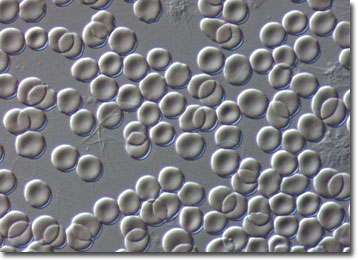Differential Interference Contrast Image Gallery
Human Erythrocytes
In an average adult, each cubic millimeter of blood contains more than five million erythrocytes, which are commonly known as red blood cells. Erythrocytes are what give blood its characteristic color and are primarily responsible for transporting oxygen from the lungs to the tissues of the body and the metabolic waste product carbon dioxide back to the lungs.

Human erythrocytes generally only live for about 100 days and, therefore, must be periodically replenished. The majority of new erythrocytes develop in the bone marrow through a several stage process and are stored in the spleen. Beginning as a hemocytoblast, a cell that has multiple development potentials, in the mesenchyme, the structure slowly turns into an erythroblast, which then loses its nucleus and mitochondria and gains hemoglobin. A later stage of the cell known as a reticulocyte, is what finally develops into an erythrocyte. The entire progression from hemocytoblast to red blood cell requires two to five days to complete.
When fully mature, erythrocytes typically have a rounded, biconcave shape that gives them the appearance of a dumbbell when viewed from the side. Their design facilitates oxygen exchange at a continuous rate over the greatest possible area. Though most average humans have a small fraction of oval-shaped red blood cells as well, an unusually high number of such cells or other alternatively shaped erythrocytes is a characteristic of certain diseases. For instance, large numbers of oval red blood cells is a sign of pernicious anemia and crescent-shaped erythrocytes are a distinguishing feature of sickle cell anemia.
